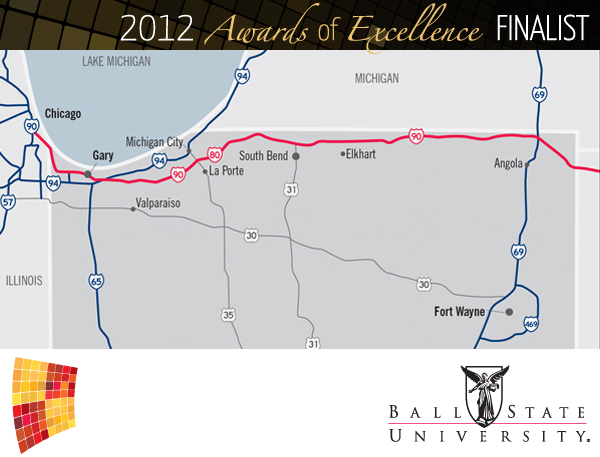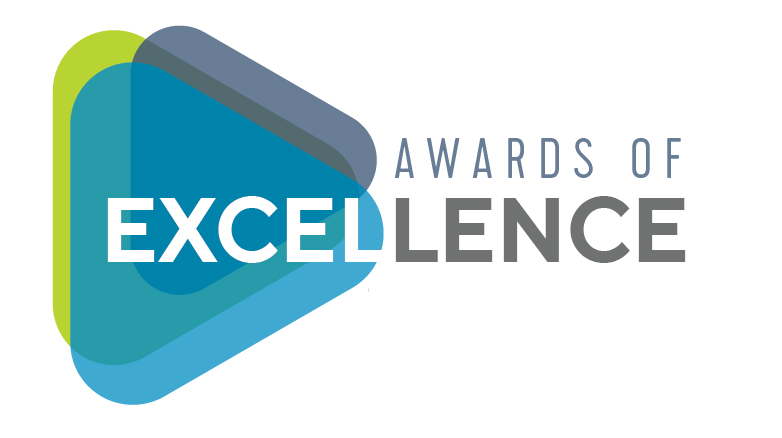Network

| Award Category: | Research and Analysis |
| Project Site: | Indiana Toll Road Economic Development Corridor Study |
| Submitted By: | Building Better Communities, Ball State University |
| Contact: | Dick Heupel, 765.285.2894 |
Case Study
Problem/Background
The Indiana Toll Road (ITR) passes through three Regional Development Districts, three Indiana Economic Development regions, three Workforce Investment regions – all without contiguous borders. In addition, the Indiana Toll Road (ITR) crosses seven counties, seven enterprise zones and a multitude of cities and towns. This highway corridor is 157 miles long and has 22 exits serving a population of more than 1.2 million. The infrastructure of the ITR links these communities and people across a large trade flow area, including greater Chicago. Chicago is the third largest container handling port in the world and is in the top 20 for rail, water, and air transport. The Chicago National Transportation Analysis Area (NTAR) ships and receives more than 1.5 billion tons of goods and more than one-third of the nation’s rail and overland truck traffic. The freight volume of the Chicago area exceeds major trade centers such as Los Angeles. As international trade continues to grow, this will fuel the growth of containerized intermodal shipping. This region holds national importance with respect to commodity flows and is host to a large share of several manufacturing sectors, large research universities, and broad agricultural resources. Recognizing the importance of this region to the performance of the national and state economies and as home to more than half a million Hoosier families, the Indiana Toll Road Economic Development Corridor Study initiative (ITREDCS) commissioned this study.
Solution
The study was performed in three phases. The purpose of this Phase 1 analytical process was simply to evaluate whether or not economic development opportunities exist along the Corridor that could be furthered by future economic development efforts. During Phase 2 of the study, exhaustive analysis of activities occurring within the Corridor region was performed and 15 economic opportunity briefs summarizing potential development opportunities gained through research were developed. In Phase 3, a final report was produced detailing the Indiana Toll Road Economic Development Corridor Study after periodic in-progress reviews and meetings with the Toll Road Study Group. This study entailed a carefully-planned and rigorous research methodology involving a thorough review of existing studies, detailed statistical and empirical modeling, and in-depth qualitative data collection and analysis using state-of-the-art practices. The study identified three objectives for economic development.
- Establish the Indiana Toll Road Corridor as the nexus of growth in central North American transportation.
- Diversify business development efforts on a sub-Corridor regional basis.
- Position the Indiana Toll Road Corridor as a preferred location for economic development activity.
The expected outcomes of implementation would occur from the first-listed objective over the long-term (10 to more than 25 years), from the second objective over the medium term (five to 10 years), and the third over the immediate term (one to five years).
Results
This research uncovered considerable agreement on general objectives for the economic development of the Indiana Toll Road Economic Development Corridor. The strategies delineated in this study support these objectives and are directly connected to the study’s quantitative and qualitative research findings that were developed through an integrated methodology involving economic research, stakeholder input and facilitation, and strategy delineation. This approach is consistent with the study outline which included an analysis of best practices and recommendations from existing studies, empirical analysis of other corridor development efforts, detailed review of the Corridor region’s economies, as well as collection, review, and analysis of stakeholder input from a variety of sources.
Future Considerations
This project provides a gateway of opportunity for further research, public policy development, and collaboration among multiple players in the Chicago-Northern Indiana area. Research opportunities include commodity flow analyses to identify development opportunities and economic sector studies to identify growing markets that can be served in and around the Corridor. Public policy opportunities include garnering support for a long-term solution to relieve transportation congestion in the Corridor, a condition estimated to create a $4 billion drag annually on the region’s economy. Collaboration opportunities include further development of an organized initiative to oversee and steward research and policy development, to target key development opportunities in transportation efficiencies, and more effectively market the Corridor for economic growth.
Finalist Presentation
UEDA Awards of Excellence Finalists presented at the Annual Summit in Chattanooga on October 22, 2012. Summit attendees then voted for the best initiative in each category.

